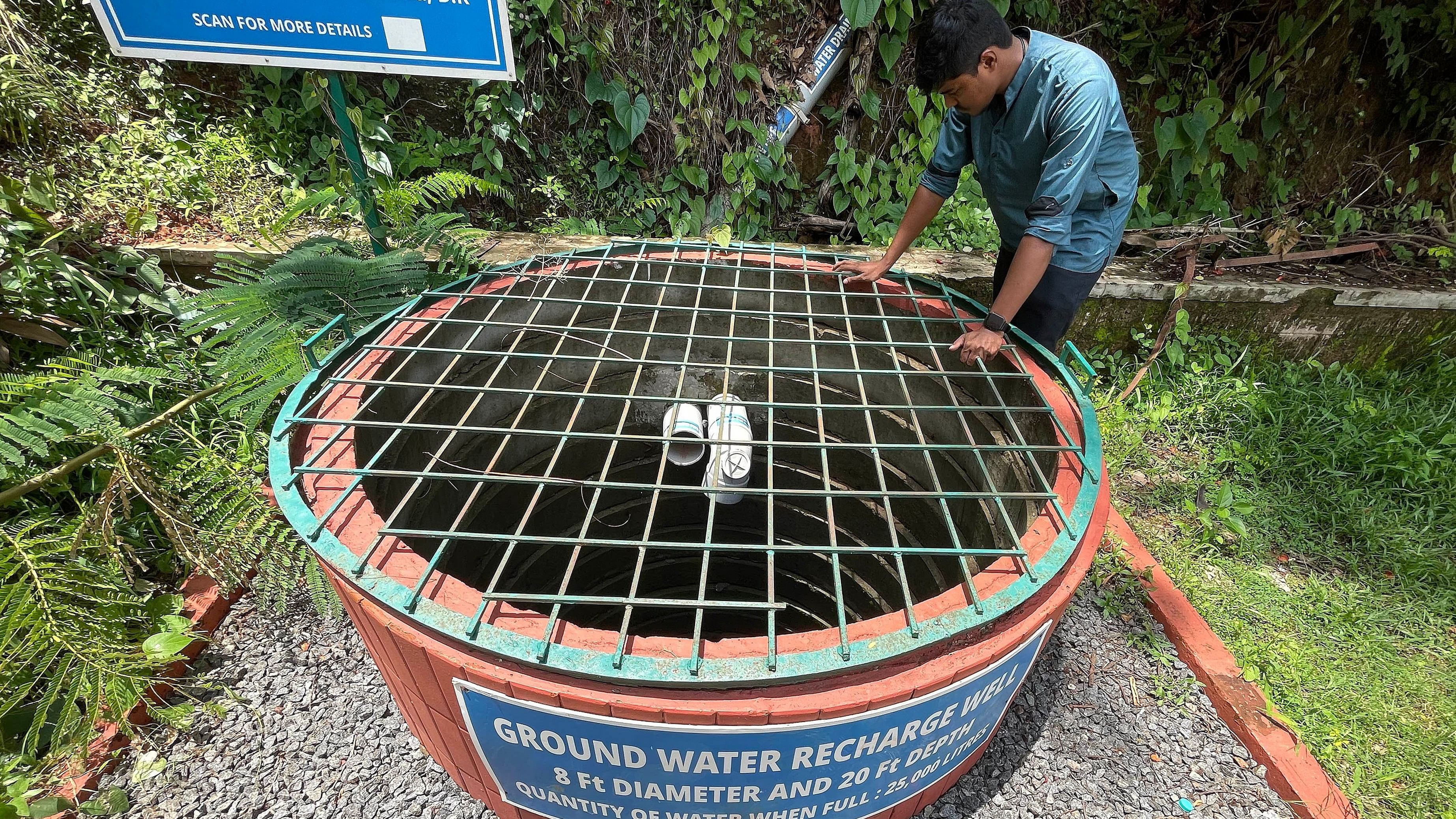
A groundwater recharge pit situated in a Mangaluru-based college.
Credit: DH Photo/FakruddinH
Every drop of water counts. This is a lesson some students in Dakshina Kannada learned from observing rainwater harvesting techniques. Schools and colleges are uniquely positioned to implement and benefit from rainwater harvesting systems by recharging borewells and open wells through cost-effective methods. Students can also be involved in the process of setting up percolation pits, thereby raising awareness about water conservation.
At the Government First Grade Women’s College campus in Balmatta in Mangaluru, this process began two years ago. A century-old open well faced the threat of closure to facilitate the construction of a new building on the campus. Instead, the principal Jagadish Bala decided to implement rainwater harvesting programmes to recharge the well. When a 500-square-metre plinth area was constructed, water from the roof was channelled into two water tanks, where it was purified using pebbles and sand before being used to recharge the open well.
Bala says that water supplied by the Mangaluru City Corporation is used only for drinking purposes and the water from the open well is used in wash basins and toilets on campus.
According to Bala, one litre of rainwater can be collected if one square metre area receives 1 mm of rainfall. Mangaluru gets an average of 3,500 mm of rainfall annually. With a 500-square-metre roof, if 90% of the water is collected, then 15,75,000 litres of water can be used to recharge the open well. The college requires an average of 6,000 litres of water daily, amounting to 14,40,000 litres annually. This means an additional 1,35,000 litres of water is recharged into the well from the roof.
Eco-friendly initiative
The St Aloysius group of institutions, situated in the heart of Mangaluru city, is also focusing efforts towards water conservation. The administration has decided to implement rainwater harvesting in five phases. So far, three phases have been implemented. In the first phase, rainwater from the roofs of campus buildings was diverted to the water outlets on campus. In the second phase, water from the interlocked floors on campus was channelled to a large tank, where it was filtered using gravel, sand, and charcoal, and connected to an 80-foot-deep well. The water from the well is used to water the gardens on campus from October to May.
“When tested, the water in a campus borewell had high metal content. Now, rainwater percolates into the borewell through the pit we dug next to it. We hope that recharging this borewell will help dilute the metal content, making the water potable,” says campus green initiative officer Akash Kudla.
“We wanted the 16,000 students on campus to learn about rainwater harvesting and the importance of water conservation. We thought it would be more prudent to lead by example and contribute to improving the groundwater in the area,” says Melwyn Joseph Pinto, rector, St Aloysius Institutions.
Addressing a crisis
Recharging a borewell using rainwater harvesting has helped the Government Composite PU College, in Vogga of Bantwal taluk, overcome the water crisis during peak summer.
“With the help of a donor, we built infrastructure to divert water from the roof of the school building to recharge a borewell. A pit was also constructed around the borewell,” says school headmaster Adam Saheb. “Recharging the borewell has helped avoid muddy water during peak summer as the availability of water has increased,” says Adam Saheb.
Percolation pits
Since 2019, the students of Carmel Girls High School in Modankap, Bantwal, have been digging percolation pits during July and August to create awareness about rainwater harvesting. School teacher Roshan Pinto, who is also the coordinator of the eco club, says that under the ‘Green Future’ initiative, students dig percolation pits on available land near their houses or in hilly areas. About 470 percolation pits have been dug by students so far.
Mishal Lobo, a Class 10 student, says, “The digging of percolation pits in the surroundings of my house has helped increase the water level in the open well owned by my family. Earlier, the well used to go dry and my family had to fetch water from my neighbour’s house. However, we did not face any problems during peak summer this year.” Mishal had dug six percolation pits when she was in Class eight and 20 pits last year.
Pinto explains that the goal was water literacy. “Students learn about rainwater harvesting and percolation pits in their science textbooks. To embed this message in young minds, we initiated this project. Since there is no space on school premises, students dig the percolation pits near their houses and send pictures to their teachers.” This initiative also helps raise awareness about rainwater harvesting among parents and neighbours.
Further, rainwater from the roof of the Carmel Composite PU College on the campus is used to recharge an open well on the premises. The campus has over 1,000 students and the water requirement of the campus is now met by the well. “Despite the deficit rain last year, the school campus did not face a shortage of water,” says Pinto.